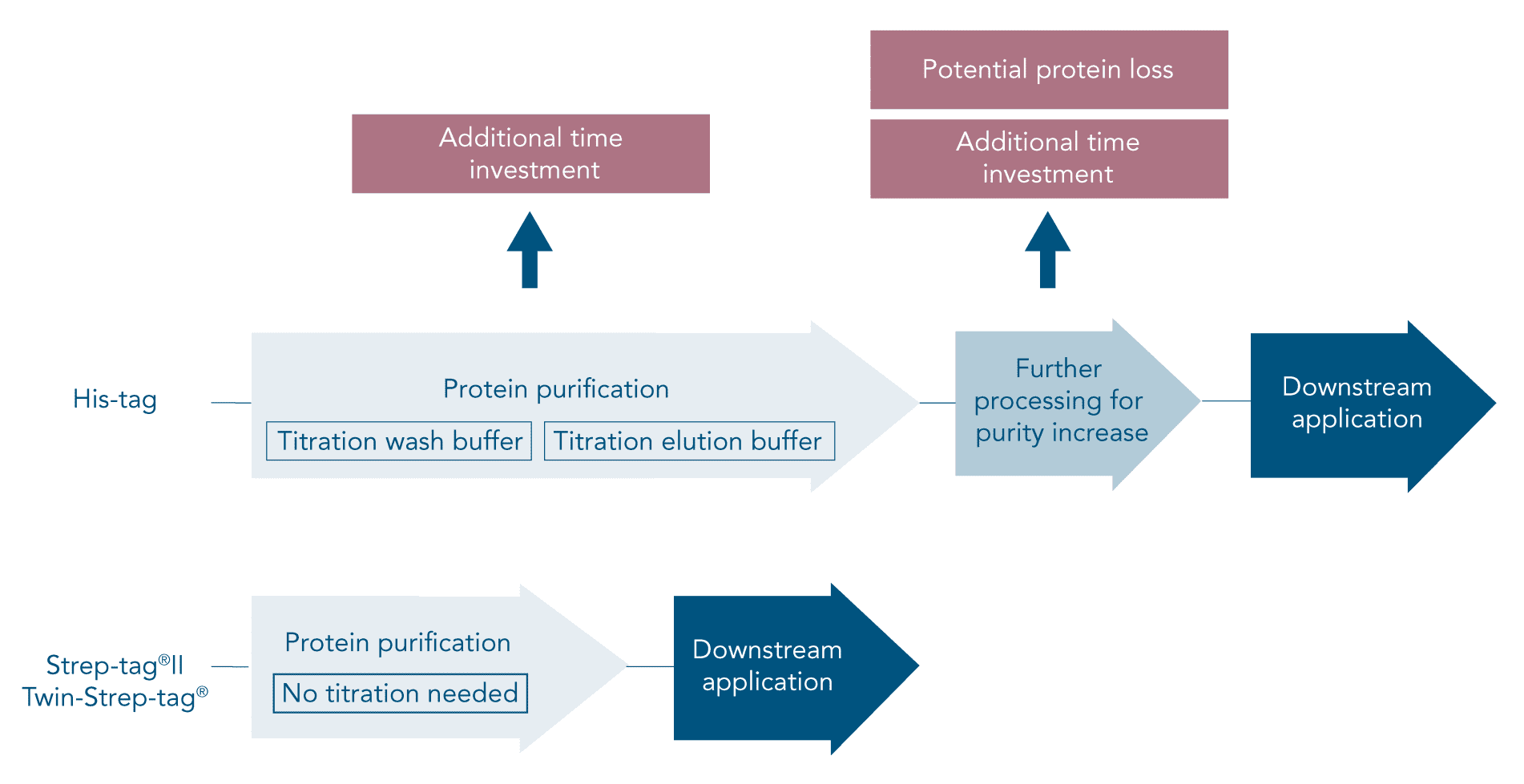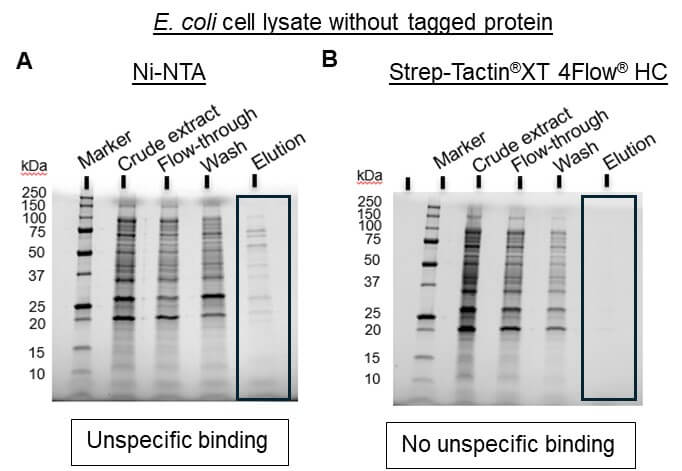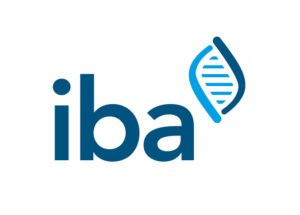Strep-tag vs. His-tag
How to circumvent common problems associated with the His-tag system?
The His-tag (6xHis-tag, His6-tag or polyhistine-tag) is a popular affinity tag for protein purification since its small size ensures a low impact on protein structure. While the His-tag system is popular for its high yield and low costs, the time and effort it takes to establish successful His-tag purification is often neglected.
The following problems are commonly associated with the His-tag system:
- Low target purity due to unspecific binding of host proteins (Figure 1A)
- Sample or buffer components interfere with protein binding
- Protein precipitation after purification due to incompatible buffer components
- Culture media for mammalian cells interfere with protein binding or cause Ni2+ leakage
- Required pH for target protein causes elution from Ni-NTA agarose
- Limited applicability in protein analysis due to low tag-ligand affinity and specificity
To avoid or address these problems, careful planning of the procedure and optimization of the His-tag purification protocol is required. In the end, a His-tag might still not achieve satisfactory results or might not be suitable at all for a certain type of protein. In this case, a different affinity tag should be considered.
The Strep-tag® system is the ideal alternative to His-tag since all common problems are avoided. Due to the specific tag-ligand interaction, protein isolation using this system leads to highly pure protein without further optimization or processing steps (Figure 1B).

Figure 1: GFP fused to either a 6xHis-tag (A) or to a Twin-Strep-tag® (B) was isolated from E. coli lysates using standard protocols provided by the manufacturers for the used resins (Ni-NTA from Thermo Fisher Scientific for His-tag and Strep-Tactin®XT 4Flow® high capacity from IBA Lifesciences for Twin-Strep-tag®)
Watch our free on-demand about common problems during His-tag purification and read our white paper comparing His-tag and Strep-tag® protein purification systems.
What are causes of impurities during His-tag purification and how to eliminate contaminants?
His-tag is bound by transition metal ions, of which nickel (Ni2+) is most commonly used. Nitrilotriacetic acid (NTA) or iminodiacetic acid (IDA) usually serve as carrier matrices for Ni2+. Within the His-tag purification system, which is a type of immobilized metal affinity chromatography (IMAC), both the type of tag and the corresponding tag-binding metal ions (e.g. Ni2+, cobalt (Co2+) or copper (Cu2+)), potentially cause impurities:

Figure 2: Since His-containing proteins non-specifically bind to Ni-NTA resins, titration of wash and elution buffers are necessary. In addition, further processing steps such as e.g. size exclusion chromatography or filtration can be required to increase the purity sufficiently for further experiments. During this step, protein is lost, reducing the overall protein yield. In contrast, Strep-tag®II and Twin-Strep-tag® bind to their ligands with a high specificity, resulting in a highly pure protein preparation that can directly be used for further downstream applications.
- “His” or “Histidine” is an amino acid that may be present in host proteins. Consecutive His-residues mediate unspecific binding to the chelated metals on the His-tag purification resin.
- Host proteins may have an intrinsic affinity to Ni2+ or Co2+.
To increase the purity of His-tag proteins, several steps before, during and after the purification process offer optimization potential.
As a first step, elution agent imidazole can be added in a low concentration to the cell lysis buffer and to wash buffers. This way, unspecific binding of intrinsic proteins with His-tag can be prevented. However, the imidazole concentration that inhibits only the binding of His-containing host proteins and still allows the binding of 6xHis-tagged target proteins has to be carefully titrated. Similarly, gradually adjusting the imidazole concentration during elution can help to eliminate His-tag contaminants. If these approaches are not successful, increasing the number of His-residues from e.g. 6 to 10 achieves stronger binding of the target protein and permits higher imidazole concentrations during washing to remove contaminants. However, this means starting from scratch again, since protein expression has to be adapted.
If the purity of the His-tag target protein is not satisfactory after modifying the purification procedure, additional processing steps can be considered. These include size exclusion or ion exchange chromatography, filtration or dialysis. The disadvantages here are that all extra steps can cause protein loss and additional costs (Figure 2).
In contrast, the two tags that are used in Strep-tag®-based protein purification (Strep-tag®II and Twin-Strep-tag®) were specifically engineered for use in this technology. Therefore, unlike His residues, it is not likely that they naturally occur in proteins and subsequently bind to the purification resin (Figure 3). If any impurities occur during Strep-tag® purification, this is usually caused by biotinylated proteins, which are easily and specifically blocked with avidin. Otherwise, ready-to-use wash and elution can be applied as recommended.

Figure 3: E. coli lysate was added to Ni-NTA (A) or to Strep-Tactin®XT 4Flow® high capacity (HC) resin (B). Contaminants were only observed with Ni-NTA resin due to unspecific binding of proteins containing His residue.
Which reagents are compatible with the His-tag system?
The choice for or against a specific protein tag is strongly influenced by the properties of the target protein. Since pH values ranging from 4.5 to 6 and chelating agents such as EDTA lead to elution of His-tagged proteins, this system is not suitable for e.g. pH-sensitive proteins. The use of chelating agents also means that the transition metal ions are detached from the matrix and have to be recharged after purification. Furthermore, reagents such as DTT (reducing agent), Tris or MOPS are not recommended for the His-tag system, which further limits the broad applicability for different proteins. In addition to unwanted elution of proteins, the use of an incompatible reagent can lead to the formation of protein precipitates. In contrast, Strep-Tactin®XT resins are compatible with various reagents, making it a very flexible system for various protein classes (see table 1 for a detailed overview of compatible reagents). This way, it is suitable for e.g. membrane proteins, antibodies and metal ion containing proteins (e.g. metalloproteases).
| Reagents | His-tag system | Strep-tag® technology | |
| Reducing agents | DTT | Not recommended | 50 mM |
| β-mercaptoethanol | Up to 20 mM | 50 mM | |
| TCEP | Not recommended | 10 mM | |
| Detergents | Triton X-100 | 2% | 2% |
| Tween 20 | 2% | 2% | |
| Chelating agents | EDTA | Not recommended | 100 mM |
| EGTA | Not recommended | 100 mM | |
| Metal ion/ligand | CaCl2 | 5 mM, maximum | 1.5 M |
| Buffer components | NaCl | Up to 2 M, at least 300 mM should be used | 5 M |
| Tris | Not recommended | Possible | |
| HEPES | Not recommended | 50 mM | |
| MOPS | Not recommended | 20 mM | |
Table 1: Compatible reagents and representative values for His- or Strep-tag® based protein purification.
Which expression host is compatible with the His-tag system?
E. coli is most frequently used as expression host for His-tagged proteins. The amount of contaminants that occur during His-tag purification from E. coli cultures greatly depend on factors such as media composition and other culture conditions, genetic background of the E. coli strain and the recombinant protein that is expressed. Consequently, protocol optimization for reducing impurities have to be performed for each recombinant protein separately.
Since E. coli, is not always suitable for protein expression, especially for more complex proteins that require posttranslational modifications, alternative expression systems are needed. However, yeast and insect cell media usually have an acidic pH, which interferes with the binding of His-tagged proteins to the IMAC resin. Moreover, media for yeast or mammalian cell cultivation often contain amino acids, such as histidine, glutamine or arginine, which compete with the His-tag for binding sites.
| His-tag | Strep-tag® | |
| E. coli | Host proteins with consecutive His-residues cause contaminations | No limitations |
| Mammalia | Media contain amino acids that compete with His-tag Supplements cause stripping of nickel ions | No limitations |
| Yeast | Acidic pH media lead to protein elution | No limitations |
| Insect | Acidic pH media lead to protein elution Media contain amino acids that compete with His-tag | No limitations |
The following whitepaper shows the advantages of the Strep-tag® technology in comparison to the His-tag system within two high density mammalian expression systems, Expi293TM and ExpiCHOTM.
Another problem of isolating polyhistidine-tagged proteins from certain types of cell culture media is the stripping of nickel ions from the resin. For example, purifying His-tagged proteins from Expi supernatants with Ni-NTA resins is problematic and has been associated with a loss of target protein in the purification process.
This application note demonstrates that a standard Ni-NTA resin does not provide reliable and predictable purification results when used for protein purification from Expi supernatants. Furthermore, it shows that standard Ni-NTA resins exhibit significant reduction of binding capacity and recovery due to nickel leakage by media supplements.
Which applications are possible with the His-tag?
A prerequisite for flexible application options is the specificity and affinity of a tag-ligand interaction. The His-tag system disposes only an affinity in the µM-nM range. This affinity leads to rapid dissociation and poor immobilization. In addition, His-tag antibodies have only a low specificity and can also detect unspecific proteins with His residues arranged in tandem. A large number of analytical applications for which a high affinity and/or highly specific antibodies are necessary – such as SPR (Surface Plasmon Resonance), BLI (Bio-Layer Interferometry) – can only be addressed inadequately. Especially for kinetic measurements of high affinity interactions, the nanomolar affinity of His6-tag to NTA is not always sufficient. To circumvent this problem, a second affinity tag can be fused to the target protein. On the one hand, this potentially affects the functionality of the protein and on the other hand, additional costs are generated. The Strep-tag® technology by contrast offers an affinity in the µM–pM range. Depending on the application, the appropriate affinity can be selected. Further on, a large number of products are already available for the Strep-tag® technology, which allows a direct transition from protein purification to analytical application.
